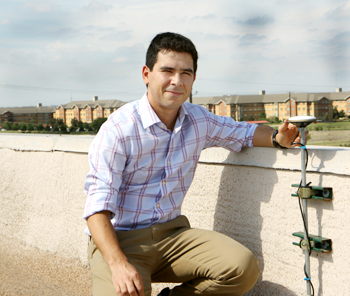
Dr. Fabiano Rodrigues was drawn to UT Dallas because of the University's strong record of research on atmospheric studies.
Dr. Fabiano Rodrigues joined the UT Dallas faculty this year as an assistant professor in the Department of Physics and in the William B. Hanson Center for Space Sciences, a research center in the School of Natural Sciences and Mathematics. One of the factors that attracted him to the University was the institution’s long history of research and expertise in atmospheric and space studies.
“UT Dallas’s Center for Space Sciences is one of the top centers focusing on satellite studies of the upper atmosphere,” Rodrigues said. “Researchers here investigate basic science questions, but they also provide important information for more applied studies, like how the atmosphere affects telecommunications and global satellite navigation systems.”
Rodrigues’s areas of expertise include remote sensing of the upper atmosphere using ground-based radars and GPS signals.
Dr. Fabiano Rodrigues
PREVIOUSLY: Before joining UT Dallas, Rodrigues was a research engineer at Atmospheric & Space Technology Research Associates.
SCHOLARSHIP/RESEARCH INTERESTS: Remote sensing of the upper atmosphere
“Fabiano adds a new dimension to our studies of the upper atmosphere, and he provides opportunities for students to get involved with the experiment design and implementation that are not so easy to do with satellite instruments,” said Dr. Rod Heelis, director of the Center for Space Sciences and Distinguished Chair in Natural Sciences and Mathematics. “With both a global perspective from our satellite measurements and now a more local perspective added with ground-based remote sensing, we are able to make new steps to understand the full range of spatial scales that affect the upper atmosphere.”
Of particular interest is the ionosphere, a region of the upper atmosphere above an altitude of about 50 miles that is characterized by a relatively large amount of free ions and electrons. The ionosphere is the region where radio signals can be reflected or scattered. Disturbances in this region can disrupt radio signals used for communications and navigation. Predicting when and where these disturbances will occur is a subject of very active research.
“How and why do the properties of the ionosphere change drastically within only a few minutes? One of my goals in coming to UT Dallas is to get students involved in this research.”
Dr. Fabiano Rodrigues
assistant professor
of physics
“Currently we can gather data to get an average picture of the ionosphere, but what we really want to better specify and understand is the short-term and small-scale variability,” Rodrigues explained. “How and why do the properties of the ionosphere change drastically within only a few minutes? One of my goals in coming to UT Dallas is to get students involved in this research.”
Rodrigues has conducted research at some of the largest and most sensitive radio observatories in the world, including the Arecibo Observatory in Puerto Rico and the Jicamarca Radio Observatory in Peru. He said he plans to engage students in on-site training and learning how experiments are done at these facilities.
Rodrigues is currently working on a project that involves deploying special GPS receivers around campus and the surrounding area to investigate the upper atmosphere and its effects on communications and navigation systems.
“The GPS data can help us better understand the physics of ionospheric disturbances, determine whether we can eventually predict when disturbances will occur, and evaluate how much trouble the ionosphere can cause to GPS performance,” Rodrigues said.
A native of Brazil, Rodrigues earned his PhD in electrical and computer engineering from Cornell University. His research has been funded by NASA, the National Science Foundation and the Air Force Office of Scientific Research.